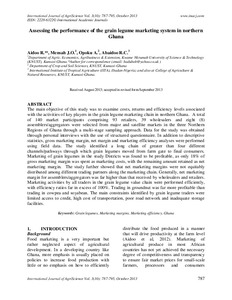| dc.contributor.author | Aidoo, R. |
| dc.contributor.author | Mensah, J. |
| dc.contributor.author | Opoku, A. |
| dc.contributor.author | Abaidoo, R.C. |
| dc.date.accessioned | 2019-12-04T11:03:55Z |
| dc.date.available | 2019-12-04T11:03:55Z |
| dc.date.issued | 2013-10 |
| dc.identifier.citation | Aidoo, R., Mensah, J., Opoku, A. & Abaidoo, R.(2013). Assessing the performance of the grain legume marketing system in northern Ghana. International Journal of AgriScience, 3(10), 787-795. |
| dc.identifier.issn | 2228-6322 |
| dc.identifier.uri | https://hdl.handle.net/20.500.12478/1283 |
| dc.description.abstract | The main objective of this study was to examine costs, returns and efficiency levels associated with the activities of key players in the grain legume marketing chain in northern Ghana. A total of 140 market participants comprising 93 retailers, 39 wholesalers and eight (8) assemblers/aggregators were selected from major and satellite markets in the three Northern Regions of Ghana through a multi-stage sampling approach. Data for the study was obtained through personal interviews with the use of structured questionnaire. In addition to descriptive statistics, gross marketing margin, net margin and marketing efficiency analyses were performed using field data. The study identified a long chain of greater than four different channels/pathways through which grain legumes moved from farm gate to final consumers. Marketing of grain legumes in the study Districts was found to be profitable, as only 18% of gross marketing margin was spent as marketing costs, with the remaining amount retained as net marketing margin. The study further showed that net marketing margins were not equitably distributed among different trading partners along the marketing chain. Generally, net marketing margin for assemblers/aggregators was far higher than that received by wholesalers and retailers. Marketing activities by all traders in the grain legume value chain were performed efficiently, with efficiency ratios far in excess of 100%. Trading in groundnut was far more profitable than trading in cowpea and soyabean. The main constraints identified by grain legume traders were limited access to credit, high cost of transportation, poor road network and inadequate storage facilities. |
| dc.format.extent | 787-795 |
| dc.language.iso | en |
| dc.subject | Grain Legumes |
| dc.subject | Marketing Margins |
| dc.title | Assessing the performance of the grain legume marketing system in northern Ghana |
| dc.type | Journal Article |
| dc.description.version | Peer Review |
| cg.contributor.crp | Grain Legumes |
| cg.contributor.crp | Policies, Institutions and Markets |
| cg.contributor.affiliation | Kwame Nkrumah University of Science and Technology |
| cg.contributor.affiliation | International Institute of Tropical Agriculture |
| cg.coverage.region | Africa |
| cg.coverage.region | West Africa |
| cg.coverage.country | Ghana |
| cg.authorship.types | CGIAR and developing country institute |
| cg.iitasubject | Grain Legumes |
| cg.iitasubject | Markets |
| cg.journal | International Journal of AgriScience |
| cg.howpublished | Formally Published |
| cg.accessibilitystatus | Limited Access |
| local.dspaceid | 78686 |

